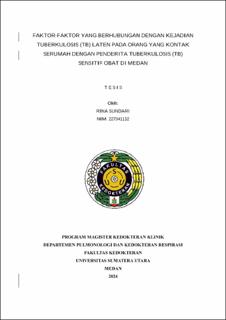Faktor-Faktor yang Berhubungan dengan Kejadian Tuberkulosis (TB) Laten pada Orang yang Kontak Serumah dengan Penderita Tuberkulosis (TB) Sensitif Obat di Medan
Factors Associated with Pulmonary Tuberculosis and Latent Tuberculosis Infection (LTBI) in Household Contacts with Drug-Sensitive Tuberculosis Patients in Medan

Date
2024Author
Sundari, Rina
Advisor(s)
Sinaga, Bintang Yinke Magdalena
Sormin, Delores Elisabeth
Wahyuni, Arlinda Sari
Metadata
Show full item recordAbstract
Background: Latent Tuberculosis Infection (LTBI) has the potential to develop into active TB. Therefore, appropriate diagnosis and management are essential, especially in high-risk populations such as individuals who are in household contact with active TB patients.
Objectives: To analyze the factors associated with pulmonary tuberculosis and latent tuberculosis infection (LTBI) in household contacts with drug-sensitive tuberculosis patients in Medan
Methods: This research is an observational analytical study with a cross-sectional design conducted in several health facilities in Medan for 12 months. This study included 105 household contacts from 67 index cases who were diagnosed with drug-sensitive TB, confirmed by Xpert MTB/RIF examination. Statistical analysis used the Chi-Square test, followed by multivariate analysis of variables. Logistic regression analysis was also carried out using the enter method. All statistical tests with a p-value <0.05 were considered significant.
Results: Among 105 household contacts with drug-sensitive TB patient, 31 people (29.6%) had latent TB infection, and 11 people (10.4%) had pulmonary TB infection. The logistic regression analysis found that the variable associated with pulmonary TB was male gender (OR 3.927; CI 95% 1.093-14.114; p=0.036). In household contacts with TB patients, no statistically significant risk factors associated with latent TB infection were found (p>0.05).
Conclusion: In household contacts with drug-sensitive TB patients, men are 4.863 times more at risk of experiencing pulmonary TB than women. However, no significant risk factors for latent TB infection were found.
